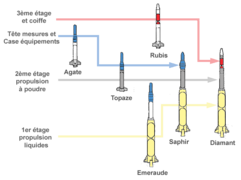 Agate VE 110 | |
| Function | Sounding rocket |
|---|---|
| Manufacturer | SEREB |
| Country of origin | France |
| Size | |
| Height | 8.50 metres (27.9 ft) |
| Diameter | 0.80 metres (2.6 ft) |
| Mass | 3,200 kilograms (7,100 lb) |
| Stages | 1 |
| Associated rockets | |
| Derivative work | Rubis, Diamant |
| Launch history | |
| Status | Retired |
| Launch sites | CIEES/CERES Ile du Levant |
| Total launches | 12 |
| Success(es) | 11 |
| Failure(s) | 1 |
| First flight | June 3, 1961 |
| Last flight | April 20, 1964 |
| First stage | |
| Powered by | NA801 Mammouth |
| Maximum thrust | 186 kilonewtons (42,000 lbf) |
| Propellant | Solid |
VE 110 Agate is the designation of an unguided French test rocket developed in the late 1950s and early 1960s.[1][2][3]
It was part of the Pierres précieuses (fr.: gemstones) program, that included five prototypes Agathe, Topaze, Emeraude, Rubis and Saphir,[3] leading up to the Diamant orbital rocket.
The Agate has a length of 8.50 metres, a diameter of 0.80 metres, a start mass of 3.2 tonnes, a takeoff thrust of 186 kN and a ceiling of 20 km. It used a NA801 Mammouth solid propellant rocket engine (same as the Rubis VE-210).[2]
The initial version was designated VE (Véhicule Expérimental) 110,[1][3] while the VE 110RR version was used to develop recovery procedures at sea.[2][3] The name indicates that it is a "Véhicule Expérimental" (Experimental Vehicle) with 1 stage, using solid propulsion (code 1), and not guided (code 0).
-
Agate and Rubis rockets

